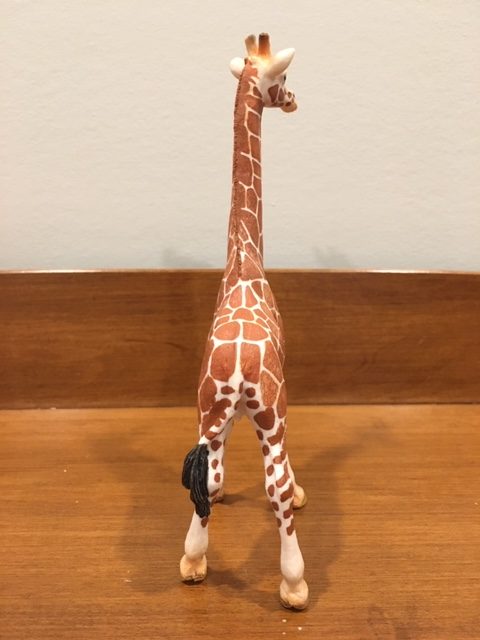Review and photographs by Suspsy; edited by bmathison1972
With their super-long necks and equally long limbs, giraffes are among evolution’s most wondrous marvels. It was long thought that there was only one species and nine subspecies, but a 2007 study proposed that there may be six species (at the very least genetic populations), including the reticulated giraffe, Giraffa reticulata. Whether these populations are deserving of species of subspecies status is still a matter of debate, but the 2007 study best demonstrates geographic, behavioral, and genetic isolation justifying population designations.

Testifying to the giraffe’s lasting popularity, Schleich has produced quite a number of them over the years, including males, females, and calves. This one here is their current female, first released in 2016. She can be recognized easily as a reticulated giraffe due to the large, polygon-shaped spots covering her body, and she can be recognized even more easily as a female due to the presence of four teats between her hind legs. She is posed standing tall and proud with her head turned to look to the right.

From the front of her chest to her rear, our giraffe measures about 7 cm deep. More impressively, she stands a good 17 cm high at the tips of her ossicones (the horn-like structures that adorn a giraffe’s cranium), which naturally makes her the tallest animal figure in my son’s menagerie to date (and puts the figure in the 1:25 – 1:33 scale). The tallest recorded female giraffe stood 5.17 metres tall, while the tallest recorded male was 5.88 metres tall. Despite being the tallest living land animals, giraffes are outweighed not just by elephants, but also rhinos and hippos.

Our giraffe’s main colours are creamy white and reddish-brown with medium brown for the short mane running down the neck. The hooves are dull gold with grey wash and the large tail tuft is black. The bulging eyes are also black, the insides of the ears are airbrushed grey, and there is red airbrushing on the muzzle and the ossicones, the latter of which also have brown tips.

Giraffes have relatively short, fine fur, and the individual who sculpted this figure did a fairly nice job of capturing this feature. The hooves have a worn, but strong appearance to them, and indeed, a well-aimed kick can take out even a lion. The tail tuft, which is essential for defense against much smaller enemies in the form of insects, looks appropriately bushy. One thing I don’t like, however, is how the tail is sculpted against the left hind leg. When it comes to animals with long tails, and a giraffe’s can measure over a metre in length, I prefer figures that don’t have their tails pressed up against any part of their anatomy. Still, this definitely does reduce the chance of breakage.

While Schleich has a mixed track record when it comes to prehistoric beasts, they have generally done very well with extant fauna, and this female giraffe certainly reflects that. Both a larger male and a young calf are also available if you’re looking to create a family unit for your collection.

Disclaimer: links to Ebay and Amazon on the AnimalToyBlog are affiliate links, so we make a small commission if you use them. Thanks for supporting us!




For all my personal misgivings about Schleich figures in recent years, this is a pretty good giraffe!
I agree and think this is one of those good old Schleich models before they started producing goofy, cartoony figures (though, there are luckily still some exceptions with their newer figures).
I was lucky I started collecting when this giraffe (and the calf) was still readily available on the shelves at a local shop (even though, I later also got the Collecta giraffe).